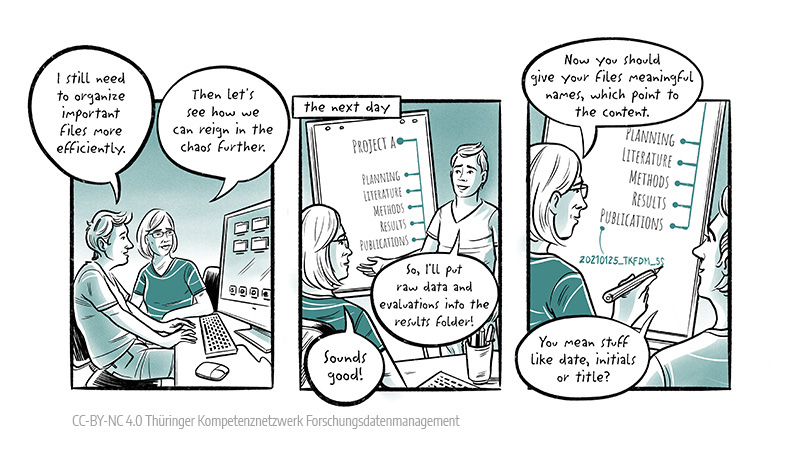5S Data - Set in order

Goal and motivation
In the second step, "set in order", folders and files should be organized in such a way that work areas in a project are better mapped and certain files can be found more easily. This saves time when working with the data and employees or people involved later can find their way around the project more easily at first glance.
Implementation
First, a folder structure should be created that corresponds to the work areas within a project. In the sciences, these are usually areas such as finances, presentations, publications, studies, source code or literature. Since sorting the folders by initial letters is often not useful, because certain areas may be more important than others, the names of the folders can be started with a number to let the operating system sort them automatically. This can be e.g. "01_studies" and "03_publications". As a rule of thumb, all folders should be easy to grasp on one level (i.e. about 7 different folders) and no more than 3 folder levels should be created in-depth so that one does not have to click unnecessarily deep into the folder structure to get to a certain file.
As already indicated in the last paragraph, the naming convention of the folders and files plays an important role. Through them, the system can already automatically make certain orders and as a human being, you can already recognize at first glance what contents the folder or the file can you expect. So that one can open the contents in a file fast, the name should already contain metadata, like e.g. the publication date, the author or creator and the title. By putting a date at the beginning of the file name, in the order year-month-day, the system can already sort them correctly in time. Another point is the use of the correct characters. Depending on the system or software, different characters in the name can cause problems when processing files. It is therefore recommended to use only lowercase letters, underscores or hyphens instead of spaces, and no special characters in file names, such as periods or question marks. For example, the name for the file of a publication would be:
"20200316_tkfdm_fact_sheet_research_data_repositories".
Since titles or other meta-information can be quite long, it should be noted here that the file name with the path of the folder structure must not be longer than 255 characters on all common systems. Care should therefore be taken to use descriptions that are as short as possible.
Of course, it is not always possible to see at first glance which files can be found in which folders. It is therefore advisable to create a readme file, a wiki page or similar at an early stage of the project that describes why this folder structure was chosen and where you can roughly find which files.
1) Sort ► 2) Set in order ► 3) Shine ► 4) Standardize ► 5) Sustain
